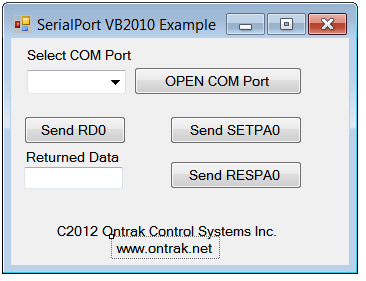

Here: The example adds a row with two strings to the DataGridView on load. After calling Rows.Add, you can use the Item accessor and the column index to assign the Value properly. The Rows.Add function will return the index of the newly-added row. We can manually add rows to the DataGridView control. So: When StandardTab is enabled, the focus will move out of the DataGridView control when the user presses tab.Īdd rows. You can change the StandardTab property on the control in the Visual Studio designer.
Vb rs232 code examples windows#
It is possible to improve the behavior for tabbing into and out of the DataGridView control in your Windows Forms program. Tip: Go to the Visual Studio designer and change the value of RowHeadersVisible to false. The screenshot shows what the row headers look like on DataGridView controls. You can hide the row headers, which are the boxes on the left of the DataGridView control, from appearing on the screen. You can see the four cells from the four values in the example in the screenshot. These two objects are reflected in the DataGridView output to the screen.

Note: It is important to declare the members as properties so the metadata can be used by the DataGridView.Īfter the Dim List is allocated, two new Test objects are added to its contents. These could be used for an inventory of merchandise. The names of these properties are Name and Cost.

The program includes the Public Class Test definition, which encapsulates two properties with backing stores. VB.NET program that uses DataGridView with class Public Sub New(ByVal name As String, ByVal cost As String) But it may be less effective than more complex approaches. Tip: This is the easiest way to get started with DataGridView. Its properties (get accessors) will be used to display the values on the screen. You can use an object collection, such as a List(Of String), in your DataGridView using the Visual Basic language. However: You will often want the CellClick, SelectionChanged, CellDoubleClick, and KeyPress events, depending on your requirements. DataGridView has many events, and this article doesn't describe them all. This allows you to manipulate the events on the control. When using the DataGridView control in Windows Forms, you should use the lightning bolt panel. This is an efficient way to populate DataGridView. It allows the DataGridView to read in the DataTable and display all its contents on the screen in grid form. The Form1_Load sub calls into the GetDataTable function, which would return a DataTable from your database in SQL Server.Īssigning the DataSource property on DataGridView copies no data. This event handler is executed when the program starts up and when the DataGridView control is displayed. ' This Function needs to build the data table. Private Function GetDataTable() As DataTable ' DataGridView1.DataSource = GetDataTable() Private Sub Form1_Load(ByVal sender As System.Object, _īyVal e As System.EventArgs) Handles MyBase.Load

Here: We use an empty DataTable on the DataGridView control. Load: You can create the Load event on the Form's event pane in Visual Studio. After you add the control, you can add the Load event on the form. First, you should add a DataGridView control to your Windows Forms application by double-clicking on the control name in the Visual Studio designer panel. Data edited in the DataGridView can then be persisted in the database.Įxample. It is an excellent way to display and allow editing for your data. They show event handlers and properties.ĭataGridView provides a visual interface to data. These VB.NET examples use DataGridView from Windows Forms.


 0 kommentar(er)
0 kommentar(er)
